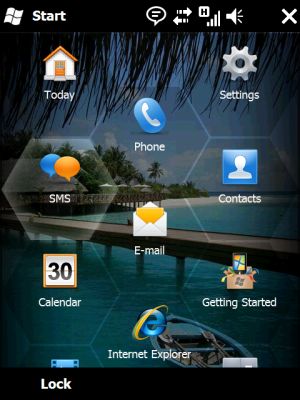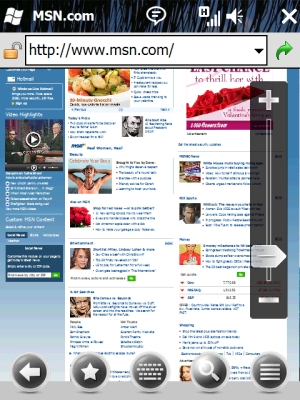
As was widely rumored, leaked, and predicted, Microsoft made a series of announcements regarding its Windows Mobile platform at the Mobile World Congress (MWC) 2009 in Barcelona on Monday. CEO Steve Ballmer proclaimed that smartphones would soon comprise 50 percent of worldwide mobile phones and that Windows would be the platform that would continue to be adopted not only on the PC but on mobile devices as well. As part of the various announcements relating to devices, software, and services, Ballmer unveiled Windows Mobile 6.5, Microsoft My Phone, and Windows Marketplace for Mobile. To simplify things, the new Windows Mobile phones would start to be marketed as "Windows phones" in the fall, which is when the new devices from Microsoft partners will begin to ship.
"Windows phones bring together the best of the Web, the PC, and the phone so you can connect instantly to the experiences you care about, no matter where you are," Ballmer said. "We're working with partners across the industry to deliver a new generation of Windows phones that break down the barriers between people, information, and applications and provide great end-to-end experiences that span your entire life, at work and at home."
Windows Mobile 6.5
Windows Mobile 6.1 is saddled with a user interface that was not really designed for finger use. Windows Mobile touchscreen devices are designed to be used with a stylus, rather than a finger, and some Windows Mobile devices do not even have touchscreens at all, resulting in a UI with lots of small buttons and menus—and none of the touch features (such as touch-based scrolling with inertia) that users now expect. Windows Mobile 6.5 replaces these old interfaces with a system designed for touch.
This new UI has two main components: a new finger-friendly Today screen, and the honeycomb Start screen. We've seen both of these in leaked screenshots and builds, and the software shown off today matches those leaked images. The new Today screen serves a similar purpose to Today screens of old, but offers large buttons, smooth finger scrolling, and considerably improved graphics. The Start screen is a new concept. It replaces the Start Menu and Programs browser in current versions with a single finger-friendly panel.
Finger-friendliness is also apparent in the newly-designed unlock and call answering screens. The unlock screen includes a simple but desirable innovation. The basic unlock action is to slide a button across the screen. What's novel is that you can jump straight from the unlock screen to other parts of the user interface (such as e-mail, text messages, or voicemail) by changing where you slide. The top position just unlocks the phone; the lower positions jump to particular locations within the software. This is a simple idea, but a useful one nonetheless. The call answering screen similarly uses slide, offering both slide-to-answer and slide-to-ignore.
Before version 6.5 was even in beta, Microsoft released an updated version of its mobile browser for Windows Mobile 6.1. Though this made big improvements to the rendering engine, the user interface remained in the Windows Mobile 6.1 era. With 6.5, not only are there further renderer improvements, but the interface itself has also been overhauled, again with the objective being greater finger-friendliness.
Microsoft stressed that it is now delivering on the demand from users to have the PC browsing experience on their phones. This means that IE will not just provide a decent renderer; it means that it will also support Flash, and allow for switching between mobile and regular versions of websites. Though others (most notably Apple) have made this claim before, the inclusion of full Flash support should lead to far greater uniformity across browser platforms than is currently possible.
Microsoft My Phone
My Phone is a backup and storage service for your phone. It moves everything from your phone up into the cloud so that you can access and manage it from anywhere, allowing you to look up and edit contact information on the Web, share photos and videos with friends, or even move your text messages and calendar appointments to a new phone. The technology is possible thanks to Microsoft's acquisition of MobiComp in June 2008.
The site for My Phone went live last week, but sign-up for the beta is only now working, so if you're interested in getting into the invitation-only beta, go there now. Although My Phone will be built-in for Windows Mobile 6.5 phones, it will also be downloadable for versions 6.0 and 6.1. The site outlines three main features for the service, which comes with only 200 MB of storage (we're a little disappointed this doesn't simply use the 25GB that every Windows Live user gets with SkyDrive).
Automatic syncing can be set up to run automatically every day at a time of your choosing, or you can force the sync at any time (in a manner similar to Windows Update, say). In this way, calendar items, contacts, tasks, appointments, text messages, and other information are kept up-to-date in the cloud. It also allows the user to store music, photos, documents, and videos at a third location (the first two being your Windows phone and the second being your PC).
According to the unofficial roadmap, Microsoft is already planning My Phone versions 1.0, 1.5, and 2.0. While version 1.0 will be a free and ad-supported, a subscription-based premium service will come sometime this summer, when Microsoft starts testing version 1.5. Officially, there are no plans to offer the service for non-Windows phone operating systems, but unofficially there are plans to extend it to non-Windows platforms this summer. Version 2.0 will be integrated with other Microsoft properties like Live Mesh and the new Windows Marketplace for Mobile, providing users with a way to buy and store applications and their data on remote servers.
Windows Marketplace for Mobile
Originally codenamed SkyMarket, Windows Marketplace for Mobile was meant to ship with Windows Mobile 7, but since that has been delayed to sometime in 2010, it will now arrive with 6.5. The marketplace, which goes beyond the current Windows Mobile Catalog, will provide direct-to-phone mobile applications and will be accessible from both the Windows phone and the Web. Users will be able to use the marketplace to find and purchase mobile applications with their Windows Live ID.
Although applications on Windows Marketplace for Mobile will undergo a simple security and compatibility check, it looks like they won't be subject to the same kind of arbitrary scrutiny as software on the iTunes store. Microsoft will also host its own applications on the marketplace. At MWC, the company also announced Microsoft Recite, a voice search technology for Windows phones version 6.x, which lets users capture, search, and retrieve spoken notes using just their voice. The website with the Technology Preview became available yesterday, demonstration video and all.
Beyond 6.5
Windows Mobile is in need of some serious love from Microsoft. In spite of Microsoft's relatively long history in this market, the much newer mobile phone operating systems from both Apple and Google (not to mention the forthcoming Palm webOS) have in most regards trounced Windows Mobile, leaving Redmond playing catch-up.
The improvements in 6.5 will certainly go some way towards redressing this deficit. Making the UI finger-friendly will address probably the biggest problem with Windows Mobile as it currently stands. Microsoft's attempt to cram the desktop Windows interface into a phone haven't resulted in a pleasant UI; Windows Mobile is too fiddly, too cluttered, and too complex. The new 6.5 UI looks like a big improvement, giving Windows Mobile users a proper touch interface that works without a stylus.
That said, there still appears to be ample scope for improvement. Some parts of the new OS are apparently untouched; Windows Media Player, for example, is unchanged from 6.1—meaning it's still going to need a stylus. This kind of jarring inconsistency makes for an extremely unpleasant user experience, and it looks like we will have to wait for Windows Mobile 7 (which will hopefully have a more Zune-like media player) before that gets remedied. The piecemeal approach taken in 6.5 is never going to deliver the coherent interface that we see on competing devices that have been designed from the ground up for touch.
Windows Mobile 6.5 is not going to put an end to the diversity of hardware capabilities currently seen in the Windows phone market, either. Although there are compulsory requirements—Windows Mobile 6.5 hardware must all have a set of hard keys to do things like open the Start screen—specifications like the screen resolution and even the presence of a touchscreen are still going to be up to the hardware vendors. This variation makes it much harder for both Microsoft and third parties to deliver truly compelling Windows Mobile software. Even a measure as simple as mandating a touchscreen would enable software vendors to tailor their software to the hardware much more effectively than is currently possible.
As flexible as the hardware specs are in some ways, they're lacking in others. Chief among the deficits is the lack of support for capacitative touchscreens. All touch-enabled 6.5 devices will have resistive touchscreens. The upshot of this is that they will all also lack support for multitouch.
With Windows Mobile 7 still not likely until April 2010, Windows Mobile is going to continue to have a tough time against competing phone platforms. 6.5 is certainly a necessary update, and My Phone in particular also looks compelling, but this release fails to knock our socks off. It will probably appease current Windows Mobile users and dissuade them from defecting, but for the buyer entering the smartphone market for the first time, non-Windows platforms are still going to have a considerable lead.


reader comments
38